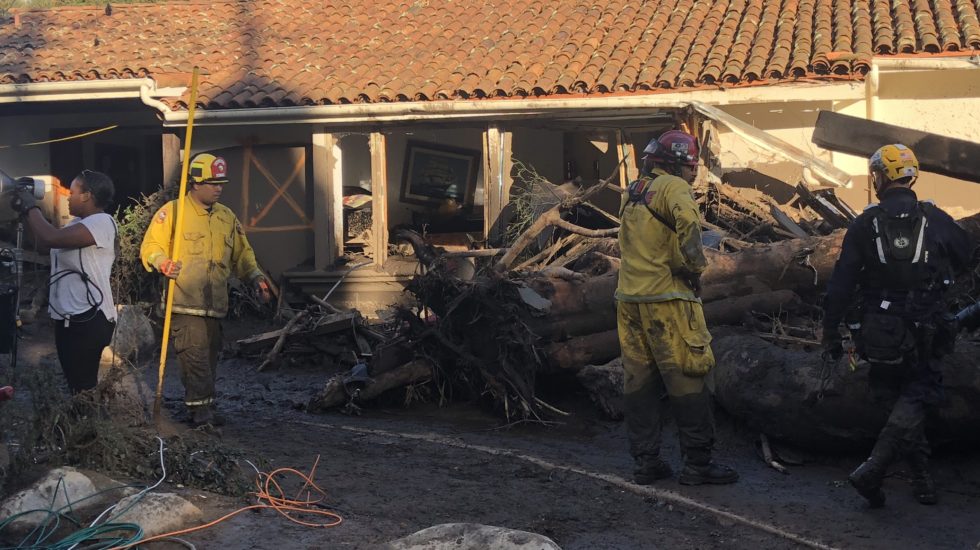Tonight is a big night in Santa Barbara County California. For the first time since January 9th, Highway 101 is open. It’s taken workers nearly two weeks to clear the rivers of mud and debris from the freeway.
The residents of Santa Barbara County have been through hell. First, it was the Thomas fire back in December. Then it was a wall of water and mud that came down the mountain, washing away parts of Montecito earlier this month. 20 people died. It will take months for the area to return to anything resembling normal. We spoke to two families who lived through it all. This is their story.
————
On the night a wall of mud and ash descended on their quiet neighborhood, Bill Ekeler’s wife, Heather, shook him awake with a start. “Bill, there’s something strange–the skylight is orange,” she told him. So the father of three went down to the kitchen to get a better look. There, he saw a “massive orange glow” coming from the low hills to the north and east.
Worried for the safety of his wife and kids, as well as the well-being of his in-laws and their two children who had been evacuated the day before and were asleep in the basement, Ekeler jumped in his son’s car and drove in the direction of the glow.
The rain was pouring hard, and Ekeler heard a strange roar–what sounded like a jet engine. He soon realized the fire was the least of his worries. “Right in front of me there was a wall of 6 or 8 feet of water and the fastest growing river that you’ve ever seen,” Ekeler says. He didn’t waste any time getting back to his home.
In the week that has passed since the worst mudslides in 20 years enveloped this otherwise picturesque community, shellshocked families like the Ekelers are doing their best to cope with the trauma of that night and its aftermath–both mindful and fearful of the fact that another heavy rain could cause yet more damage.
It was just last month when a fire created the conditions for all this mud. It was called the Thomas fire and it burned nearly 300,000 acres across southern California. The hills around Montecito was ground zero for the fire. Vegetation was incinerated for miles.
But by New Year’s Eve, thinking the worst was finally behind them, Montecito residents were able to settle back in. The fires were under control. A voluntary evacuation alert was issued when the rain started falling, but most residents stayed put. Having survived the fires, they could not imagine what was about to come.
Meanwhile, state and local officials are scrambling to clear debris. Cable and gas companies are working around the clock to restore service to thousands of customers. Emergency water distribution sites have been set up. A fleet of bulldozers and dump trucks have been deployed to clear an impassable stretch of Highway 101 though officials caution the crucial freeway will remain closed “indefinitely.” By the last count, 120 homes have been lost and 20 people have died. Three are still missing.
Down Olive Mill Road, the Ekelers’ friend Susan Moe woke up that night to the same roaring noise and livid sky. From her window, she watched as both her front yard and her backyard were inundated with mud and water. “We were completely trapped,” she says. “It was just a wall of water and trees and cars and debris and things that were flowing down.”
Moe spent the next few hours anxiously texting and waiting with the Ekelers and other friends. The storm intensified around 3:30 a.m., as Montecito was battered by more than a half-inch of rain in five minutes, sending boulders and mud shooting down the canyons. The rain didn’t ease up until daybreak when the Moes were rescued by firefighters.
Surveying the destruction, they soon realized that the wall separating their property from their neighbor’s had, in fact, saved their lives. “These trees and cars were stopped by that wall and that prevented them from coming into our bedroom windows,” she says. “It makes me shake just thinking about it.”
As the day went on, neighbors picked through the rubble and joined impromptu search parties looking for missing residents. A mother and one of her daughters were found, but a second daughter and stepdaughter remained unaccounted for. Even these modest efforts were quickly hampered by adverse conditions, however, and the sheriff soon asked volunteers to let the professionals take over. “The mud itself was so thick, it was almost the consistency of Cream of Wheat,” Ekeler says, “Almost like quicksand.”
The bodies of the two girls were later recovered.
With no access to cable TV or the Internet for news, residents relied on word of mouth to learn about the fate of their neighbors. Ekeler soon learned that Connor McManigal, 23, had been swept into the storm along with his father John, 61. “Connor ended up almost a mile down in the 101 with broken ribs,” says Ekeler. His father did not survive. “It’s stuff like that,” Ekeler says. “When you see that people traveled that far and survived, and some didn’t.” Ekeler later went to check on the McManigals’ home to see if he could find their cat for Connor, who is recovering in a local hospital. What he found shocked him anew. “When I got up to where his house was,” Ekeler says, “the house wasn’t there.”
Harder still is explaining to his three kids that some of their school friends and classmates’ parents were lost in a tragic instant. “It’s been very, very traumatic for him,” says Ekeler of son Blake, 13, with whom he watched the National Championship college football game only hours before all hell broke loose. “He doesn’t really understand it and, as a parent, you really don’t know what to say.”
